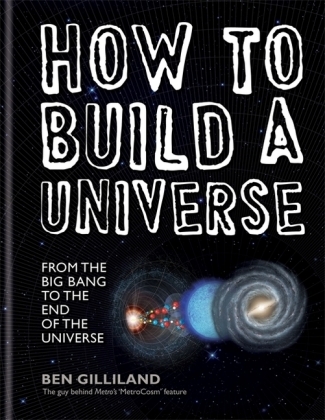
How to Build a Universe: From the Big Bang to the End of the Universe
Seiten
2015
Cassell Illustrated (Verlag)
978-1-84403-809-1 (ISBN)
Cassell Illustrated (Verlag)
978-1-84403-809-1 (ISBN)
- Titel ist leider vergriffen;
keine Neuauflage - Artikel merken
Ben Gilliland, author of the Metro's popular MetroCosm column, explains how the idea of the Universe 'being born' came to be, with a step-by-step guide to creating a cosmos.
From the first particles of matter and atomic building-blocks to hydrogen fusion, large galaxies and supermassive black holes, with a healthy dose of history and fun facts to glue everything together, this is your very own guide to How to Build a Universe.
Using a mixture of eye-catching graphics, humour and structured narrative, in How to Build a Universe, Metro columnist Ben Gilliland explains the complex concepts surrounding the birth and development of the galaxies, without overwhelming or patronising the reader.
Gilliland demonstrates how the cosmos came to be - from the formation of the first particles in the Big Bang to the development of the first stars, galaxies, planets and leading up to the present day and where the future of the universe might lie. Each chapter has an ongoing narrative, building the universe piece by piece, with graphics and fact boxes interspersed throughout.
From the first particles of matter and atomic building-blocks to hydrogen fusion, large galaxies and supermassive black holes, with a healthy dose of history and fun facts to glue everything together, this is your very own guide to How to Build a Universe.
Using a mixture of eye-catching graphics, humour and structured narrative, in How to Build a Universe, Metro columnist Ben Gilliland explains the complex concepts surrounding the birth and development of the galaxies, without overwhelming or patronising the reader.
Gilliland demonstrates how the cosmos came to be - from the formation of the first particles in the Big Bang to the development of the first stars, galaxies, planets and leading up to the present day and where the future of the universe might lie. Each chapter has an ongoing narrative, building the universe piece by piece, with graphics and fact boxes interspersed throughout.
Ben joined the Metro newspaper (official circulation figures of 1.5 million) in 1999 as a graphics editor, and started the weekly MetroCosm science column in 2005, which allowed him to use his illustrative skills to explain some of science's most complex ideas. Since then MetroCosm has increased to a two-page regular feature and has become one of the paper's most popular sections. In 2013 he won the Sir Arthur Clarke Award for Space Achievement, Media: Broadcast and Written.
| Erscheint lt. Verlag | 5.1.2015 |
|---|---|
| Verlagsort | London |
| Sprache | englisch |
| Maße | 197 x 253 mm |
| Gewicht | 904 g |
| Themenwelt | Sachbuch/Ratgeber ► Natur / Technik ► Weltraum / Astronomie |
| Naturwissenschaften ► Physik / Astronomie ► Astronomie / Astrophysik | |
| ISBN-10 | 1-84403-809-2 / 1844038092 |
| ISBN-13 | 978-1-84403-809-1 / 9781844038091 |
| Zustand | Neuware |
| Haben Sie eine Frage zum Produkt? |
Mehr entdecken
aus dem Bereich
aus dem Bereich
die Suche nach der Urkraft des Universums
Buch | Hardcover (2023)
Klett-Cotta (Verlag)
CHF 34,95
Perspektiven auf die Menschheit
Buch | Hardcover (2024)
Klett-Cotta (Verlag)
CHF 34,95


